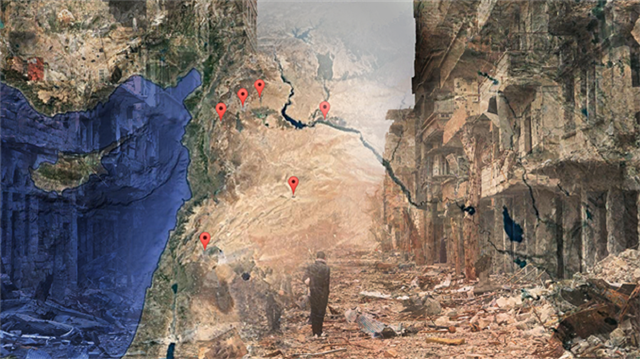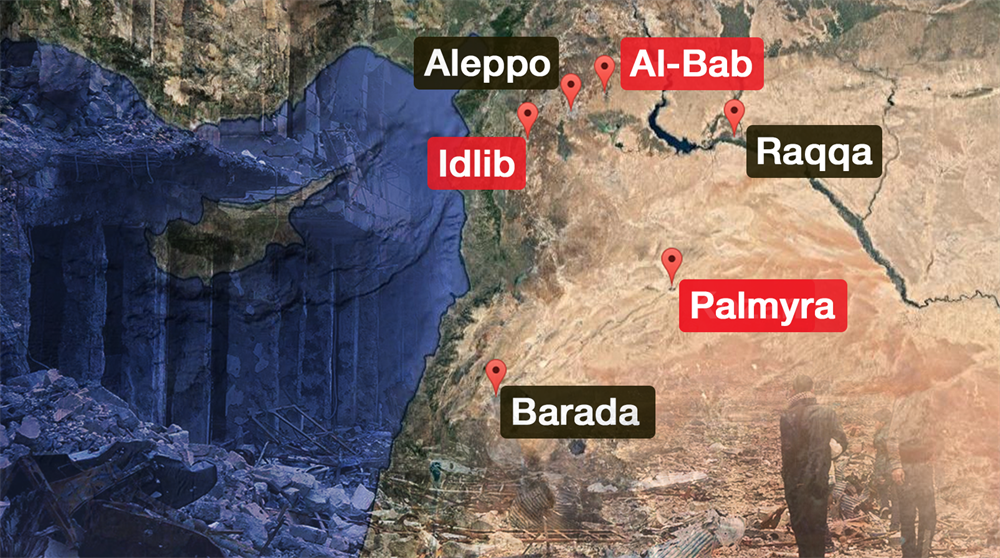
Aleppo, al-Bab, Idlib, Palmyra, Raqqa and Barada are listed as most significant strategic areas that are providing the Assad regime or terrorist organizations an advantage in the Syrian Civil War
As many as six Syrian areas bear significant importance, as they provide an advantage to the party that has the control of any of the districts.
Aleppo, al-Bab, Idlib, Palmyra, Raqqa and Barada are the strategical points which turn on a dime of the Syrian Civil War.
Aleppo
The northern Syrian city of Aleppo is a significant region due to being on the route from Syria to Anatolia or the Mediterranean.
Captured by the opponents in 2012, Aleppo witnessed a fierce battlefield after Iran and Lebanon's Hezbollah came to the city with armed militias in order to assist the regime.
Russia and the Iran-backed Assad regime intensified its attacks on the Syrian province of Aleppo, on November 15, although it had been launching attacks on the city for weeks.

The heavy bombardment was followed by the evacuation of thousands of people from the opposition-controlled part of the city, as a result of international efforts.
The last cortege was evacuated from the moderate opposition-held districts of Aleppo last week and air strikes resumed in opposition-held areas of the countryside near Aleppo.
After the evacuation, the Assad regime seized the control of the city.
Humanitarian aid shipments were not allowed to be sent into East Aleppo whose connections to other opposition-held regions had been cut off since August of 2015.
Al-Bab
The Al-Bab district of Aleppo is the second significant area in Syria. The village has been witnessing the Turkey-backed Euphrates Shield operation against terrorists, particularly Daesh.
The intersections that surround the village makes the village strategically important.
Al-Bab, which translates as door, can be considered as a 'door' that is on the route from Daesh-held Deir ez-Zor, Raqqa and the Turkish border.
Idlib is both strategically and symbolically important as the city is the last district that is being controlled by the moderate opposition.
Idlib is a connection point of Damascus and Jordan along with Aleppo and Latakia.
Along with its historical importance, Palmyra is important due to connecting Iraq, Syria and Jordan.
The area has been witnessing intense clashes between the Daesh terrorists and Syria's Bashar al-Assad forces.
Daesh took control of Palmyra, located in Homs province, from the Assad regime in 2014. After intensified clashes, the antique city started to be controlled by the Assad regime again earlier in 2016; however, Daesh took the control of the city back from the regime forces in the year's last quarter.
Raqqa, the de-facto capital of Daesh, has an important geopolitical position due to lying next to the Euphrates River that can be counted as the most important source of electric and water of Aleppo before the war. Raqqa is important to link Syria and Iraq as it is close to the Iraqi border. The position of the city enables easy connection between Daesh terrorists in two countries.
The Barada town, located 16 kilometers from the center of Damascus and 12 kilometers from Lebanon's border, contains a strategic water source Ain al-Fija. Therefore, the town is under intense attacks of Iran and Russia-backed regime forces.
In Barada, 100,000 people are currently residing. The non-governmental organizations and activists express their concerns for the high possibility of Barada turning into an Aleppo, as Assad forces have been launching intense attacks for a week now.
Hello, the comments you share on our site are a valuable resource for other users. Please respect other users and different opinions. Do not use rude, offensive, derogatory, or discriminatory language.
The floor is all yours.












